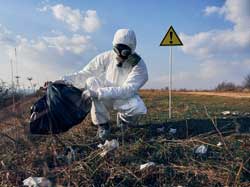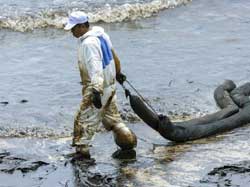Online Hazwoper Training Courses
Meet OSHA Training Requirements for Hazwoper Workers
We offer online 24 and 40-hour HAZWOPER training courses, as well as an online 8-hour HAZWOPER annual refresher training course. Register now and start training as soon as you want. Log in and out of your HAZWOPER course at any time (24/7/365), even from different computers, to train at your own pace. Print your certification of completion as soon as you finish your online HAZWOPER course.

HAZWOPER 40-hour Online Course

HAZWOPER 24-hour Online Course

HAZWOPER 8-hour Annual Refresher
The general training requirements for workers at hazardous waste clean-up sites are as follows
- General site workers, such as general laborers and equipment operators – Any such employee having actual or potential exposure to hazardous substances or health hazards must receive at least 40 hours of off-site classroom training, followed by at least three full days of directly-supervised experience in the field, per 1910.120(e)(3)(i).
- Workers who are only on site occasionally to perform a specific task, such as performing a survey or monitoring wells, and who therefore have limited exposure to chemicals at levels below the OSHA permissible limits (PELs), are only required to have 24 hours of off-site classroom training, followed by at least one full day of directly-supervised experience in the field, per 1910.120(e)(3)(ii))
- Workers who regularly work on these clean-up sites but whose activities are limited to specific areas that have been quantitatively evaluated and characterized as having low exposure to chemicals (levels below OSHA PELs) so no respirator is necessary, and that also with no potential for developing into an emergency release or exposure, are only required to have 24 hours of off-site classroom training, followed by at least one full day of directly-supervised experience in the field, per 1910.120(e)(3)(iii).
- On site managers and the supervisors who directly oversee operations and/or workers listed above that were required to have the 40-hours of training and three days of supervised field experience must also be provided with 40 hours of off-site classroom training followed by at least three full days of directly-supervised experience in the field. However, if the employees they oversee are only required by the standard to have 24 hours of training and one day of supervised field experience, then they too are only required to have 24 hours of off-site classroom training followed by at least one full day of directly-supervised experience in the field, per 1910.120 (e)(4)(iv).
Understanding the Federal OSHA HAZWOPER Standards: Scope, Application, and Training Requirements
Introduction to HAZWOPER
The Hazardous Waste Operations and Emergency Response (HAZWOPER) standard, codified in 29 CFR 1910.120, is one of the most critical Occupational Safety and Health Administration (OSHA) regulations designed to protect workers involved in hazardous waste operations and emergency response activities. Introduced in 1986, HAZWOPER covers workers exposed to hazardous substances, ensuring their safety through training, procedures, and protective measures. This article delves into the scope, application, and training requirements under the HAZWOPER standards.
Scope and Application of HAZWOPER
The HAZWOPER standard applies to five distinct groups of workers involved in the following activities:
- Clean-up operations required by governmental bodies, whether federal, state, local, or other involving hazardous substances at uncontrolled hazardous waste sites.
- Corrective actions involving clean-up operations at sites covered by the Resource Conservation and Recovery Act (RCRA).
- Voluntary clean-up operations at sites recognized by federal, state, local, or other governmental bodies as uncontrolled hazardous waste sites.
- Operations involving hazardous waste conducted at treatment, storage, and disposal (TSD) facilities regulated under RCRA.
- Emergency response operations for the release of, or substantial threat of release of, hazardous substances, regardless of the location.
These categories determine the level of compliance and training needed under HAZWOPER.
Key Definitions Under HAZWOPER
To understand HAZWOPER’s scope, it’s essential to define some key terms:
- Hazardous Substances: Includes hazardous chemicals, materials, and wastes regulated under the Clean Water Act (CWA), Resource Conservation and Recovery Act (RCRA), Comprehensive Environmental Response, Compensation, and Liability Act (CERCLA), and other federal laws.
- Uncontrolled Hazardous Waste Site: Locations where the presence of hazardous substances poses a significant risk and is not subject to control by a regulatory body.
- Emergency Response Operations: Activities that involve the response to hazardous substance releases or the potential release that requires immediate action to mitigate or control the situation.
HAZWOPER Training Requirements
One of the most significant components of the HAZWOPER standard is the training requirement. The level of training an employee needs depends on the nature of the work they perform, their potential exposure to hazardous substances, and the risk level associated with their duties.
The HAZWOPER standard mandates several types of training:
General Site Workers (e.g., equipment operators, laborers, supervisors): These workers need 40 hours of initial HAZWOPER training and three days of supervised field experience. They must also receive eight hours of refresher training annually.
Occasional Site Workers: Employees who work occasionally at hazardous waste sites with minimal exposure risk must complete 24 hours of initial HAZWOPER training and one day of supervised field experience, with annual refresher training.
Emergency Responders: These employees fall into several categories based on their role in the emergency response:
First Responder Awareness Level: Individuals likely to witness or discover a hazardous substance release and must notify the appropriate authorities. They need enough training to recognize the presence of hazardous substances but are not expected to take further action. No specific hourly training requirement is mandated, but sufficient training is required.
First Responder Operations Level: Personnel who respond defensively, such as containing the release from a safe distance, protecting nearby persons, or preventing the spread. These workers require at least 8 hours of training.
Hazardous Materials Technician: Workers who respond to releases or potential releases with the intent of stopping them. They need at least 24 hours of training and must demonstrate competency in specific skills, such as chemical hazard risk assessment and proper equipment use.
Hazardous Materials Specialist: Specialists who provide support to technicians, acting as liaisons with federal, state, local, or other government authorities. They need at least 24 hours of training at the technician level, with additional competency in special topics.
On-Scene Incident Commander: Individuals who assume control of the incident scene need at least 24 hours of training at the operations level and advanced competency in areas such as emergency response plans, risk analysis, and incident command systems.
TSD Facility Workers: Employees working at treatment, storage, and disposal (TSD) facilities regulated under RCRA need 24 hours of initial training and an annual eight-hour refresher.
Supervisors and Managers: Supervisors overseeing workers engaged in hazardous waste operations require additional training beyond that received by the general workers. This includes 8 hours of management-specific training on topics like the health hazards of hazardous substances and applicable regulations.
Detailed Breakdown of Training Requirements
To further clarify, let’s explore the training levels and requirements in greater detail:
40-Hour HAZWOPER Training
The 40-hour training is required for general site workers engaged in clean-up operations at hazardous waste sites or uncontrolled hazardous waste sites. This training covers:
- Understanding hazardous chemicals and wastes.
- Recognition and control of hazards.
- Proper use of PPE (personal protective equipment).
- Decontamination procedures.
- Site-specific safety practices.
- Hazard communication and OSHA standards.
- Understanding emergency procedures and incident management.
24-Hour HAZWOPER Training
For workers who are occasionally on hazardous sites or exposed to low levels of hazardous substances, the 24-hour training is sufficient. This training covers:
- Site-specific hazards.
- Use of PPE.
- Basic understanding of chemical hazards and decontamination.
- Procedures for safe work practices and emergency response.
8-Hour Refresher Training
All HAZWOPER-certified employees must undergo an 8-hour annual refresher to remain compliant. The refresher training reinforces previously learned material and updates workers on new regulations, practices, or site-specific hazards.
Emergency Response Training
The nature of emergency response training varies widely depending on the responder’s role:
- Awareness-Level Training: This is the most basic level, focusing on hazard recognition and notification procedures.
- Operations-Level Training: Expands on awareness training, teaching workers how to respond defensively without directly intervening.
- Technician-Level Training: In-depth training on stopping hazardous releases, including advanced PPE use and hazardous material handling.
- Specialist and Incident Commander Training: More specialized training that involves incident management, coordination with authorities, and comprehensive hazard assessment.
Medical Surveillance Requirements
In addition to training, the HAZWOPER standard requires that workers potentially exposed to hazardous substances undergo a medical surveillance program. This applies to:
- Workers exposed above the permissible exposure limits (PELs) for hazardous substances for 30 days or more annually.
- Employees who wear a respirator for 30 days or more annually.
- Workers involved in clean-up operations at uncontrolled hazardous waste sites and emergency responders.
The medical surveillance program includes:
- Baseline physical examinations before assignment.
- Periodic examinations based on risk exposure.
- Examinations following incidents or when symptoms of exposure arise.
- Medical consultations after exposure to hazardous substances.
Site Safety and Health Plans (SSHPs)
For hazardous waste operations covered under HAZWOPER, employers must develop and implement a Site Safety and Health Plan (SSHP). The SSHP includes:
- Hazard Analysis: Identification and assessment of chemical, physical, and biological hazards present on the site.
- Site Control Plan: Designation of work zones, such as exclusion zones and decontamination zones, to prevent contamination spread.
- Emergency Response Plan: Procedures for managing emergencies, including evacuations, emergency contacts, and incident command systems.
- PPE Selection and Use: Guidelines for selecting and using PPE based on identified hazards.
- Decontamination Procedures: Steps for safely removing contaminants from personnel and equipment.
- Medical Surveillance Requirements: Implementation of the medical program outlined earlier.
Recordkeeping and Documentation
OSHA requires employers to maintain comprehensive records related to HAZWOPER activities:
- Training Records: Documentation of initial and refresher training for all affected employees.
- Medical Surveillance Records: Includes baseline, periodic, and follow-up medical evaluations.
- Site Safety and Health Plan (SSHP): A copy of the SSHP must be accessible to all employees, and updates must be documented.
- Incident and Exposure Records: Documentation of hazardous substance releases, response actions, and any exposure incidents.
Common Challenges in HAZWOPER Compliance
Many employers face challenges in HAZWOPER compliance due to the complexity of the regulations. Some common issues include:
- Inadequate Training: Failing to provide the required training hours or omitting refresher training.
- Incomplete Medical Surveillance Programs: Not all eligible workers are included, or exams are not conducted on schedule.
- Insufficient Site Safety Plans: Failing to develop a comprehensive SSHP or neglecting to update it as site conditions change.
- Lack of Proper Documentation: Inadequate recordkeeping or loss of critical documents, especially during personnel changes or site transitions.
Conclusion
The OSHA HAZWOPER standards are essential for ensuring the safety of workers involved in hazardous waste operations and emergency response. By understanding the scope and application of HAZWOPER, adhering to training requirements, and maintaining compliance through proper documentation and site safety plans, employers can create a safer working environment for their employees.
